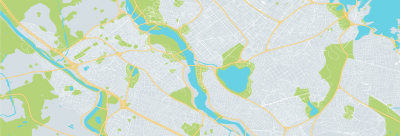Route: Chernyakhovsk, Gusev.
- 09:00 Boarding from Kaliningrad Hotel (81 Leninsky ave.);
- 09:20 Boarding from the Tourist Hotel (53 A. Nevsky St., main entrance or hotel lobby).
In the main direction of our offensive, Gumbinnen – Insterburg –Konigsberg, the German engineering defenses were particularly strong: there were up to 9 fortified strips.
It was here that the fascist command, having a large grouping of the most combat-ready troops, hoped to stop the advance of our troops.
The fighting was fierce and bloody, but the towns of Gumbinnen and Insterburg were taken.
Moscow saluted in honor of this victory on January 22, 1945 with 20 artillery volleys from 224 guns.
The units and formations that distinguished themselves most in the battles were awarded the honorary names of the Insterburg units.
The road to Konigsberg was open.
You will visit the memorial complex at the mass grave of Soviet soldiers who died during the capture of Insterburg.
You will see a monument to the commander of the 3rd Belorussian Front, General I.D. Chernyakhovsky, whose name the city of Chernyakhovsk proudly bears.
Commemorative plaques marked the buildings where the French pilots of the famous Normandy–Neman aviation regiment were stationed and where the editorial office of the front-line newspaper Krasnoarmeyskaya Pravda was located, in which the poet and front-line correspondent A.T. Tvardovsky wrote.
The city of Chernyakhovsk traces its history back to the Middle Ages, and the impressive ruins of the Insterburg castle-fortress remind us of the chivalric times.
Many famous historical figures of Europe have visited this castle.
A beautiful city with presentable residential buildings, majestic churches grew up next to the castle – the Reformed Church (now St. Michael's Cathedral of the Russian Orthodox Church) in the Neo-Romanesque style and the Catholic church of St. Bruno of Querfurt in the Neo-Gothic style, unique water towers, as well as numerous monuments to heroes of different eras: V.I. Lenin, M.B. Barclay de Tolly, a Russian soldier from the Napoleonic Wars, and a cute modern urban sculpture.
The small town of Gumbinnen went down in history during the First World War, when a major battle of Gumbinnen took place next to it on August 20, 1914.
Stunning monuments by outstanding modern Russian sculptors remind of this tragic time, the battle, and the heroes of the Russian Imperial army: "In Memory of the Forgotten War that changed the Course of History" by M. Shemyakin and "Bayonet Charge" by V. Surovtsev.
And also the church-monument of all Saints in memory of the fallen during the First World War.
During the Second World War, the city will again be inscribed in the annals of significant events: the offensive operation of the 3rd Belorussian Front on the territory of Nazi Germany, the Gumbinennsky breakthrough, will be named after the city.
Nowadays, the city is proudly named after the Hero of the Soviet Union, Captain S.I. Gusev.
A bust and monument were erected in his honor.
The memory of the defenders of our Fatherland is immortalized in the monument "IS-2 Tank".
The city itself will delight your eyes with its beautiful ancient architecture: the majestic building of the District Government on the main square, next to the delicate neo-Gothic building of the national bank, the strict Lutheran Salzburg Kirche (church).
And, of course, the symbol of the city's past is the bronze moose sculpture by the talented German sculptor L. Vordermayer.
The tour duration is 8-9 hours.









































